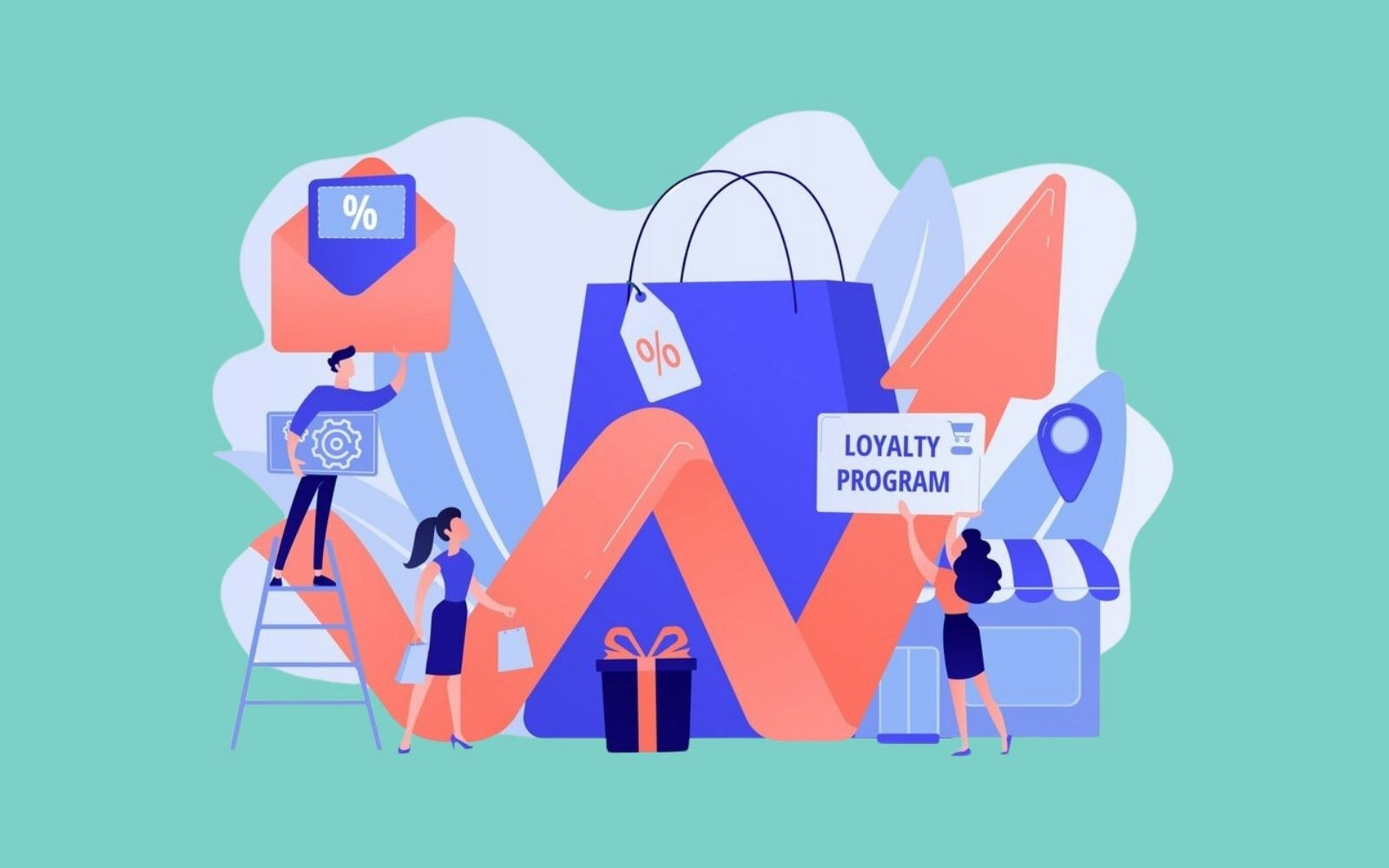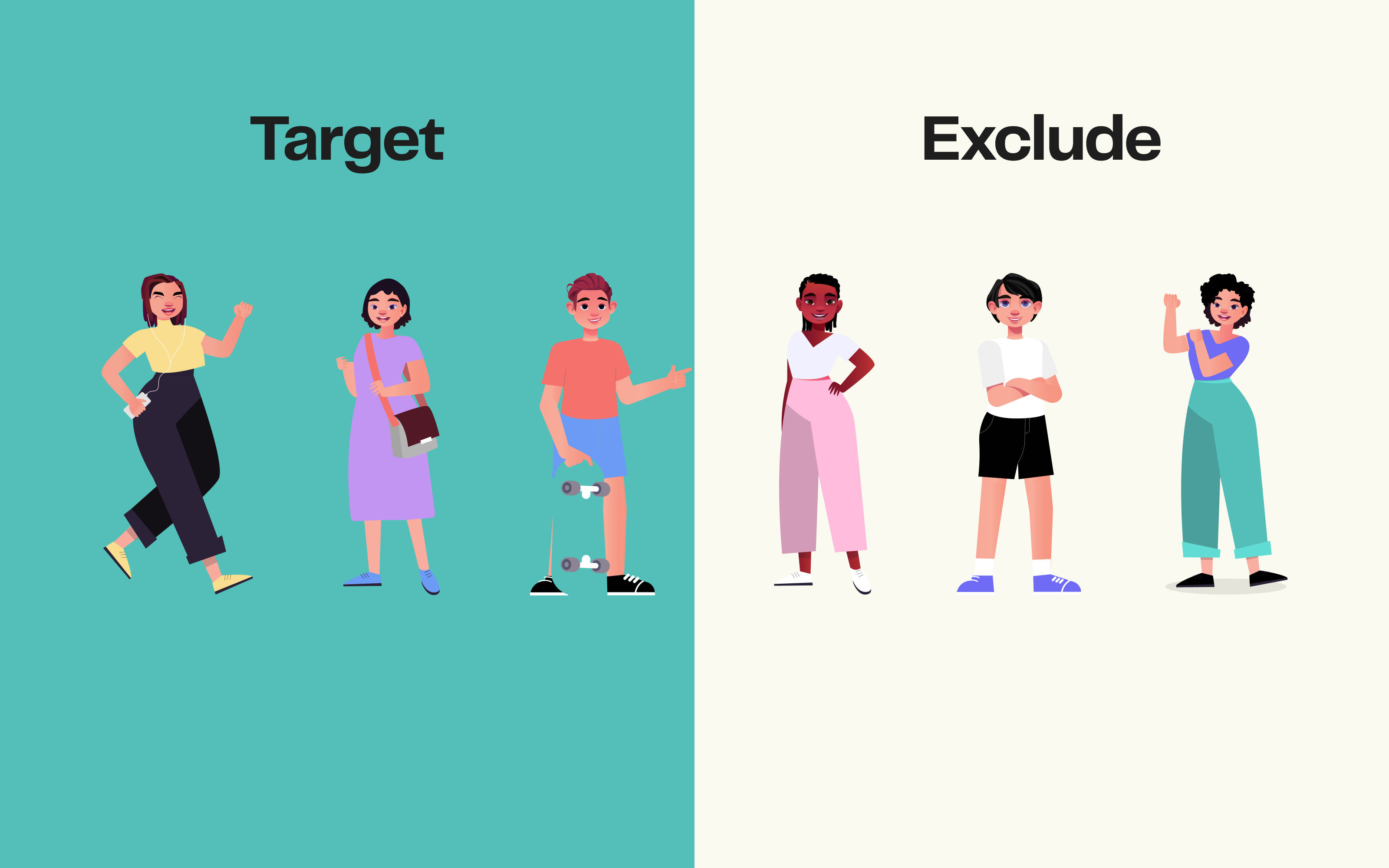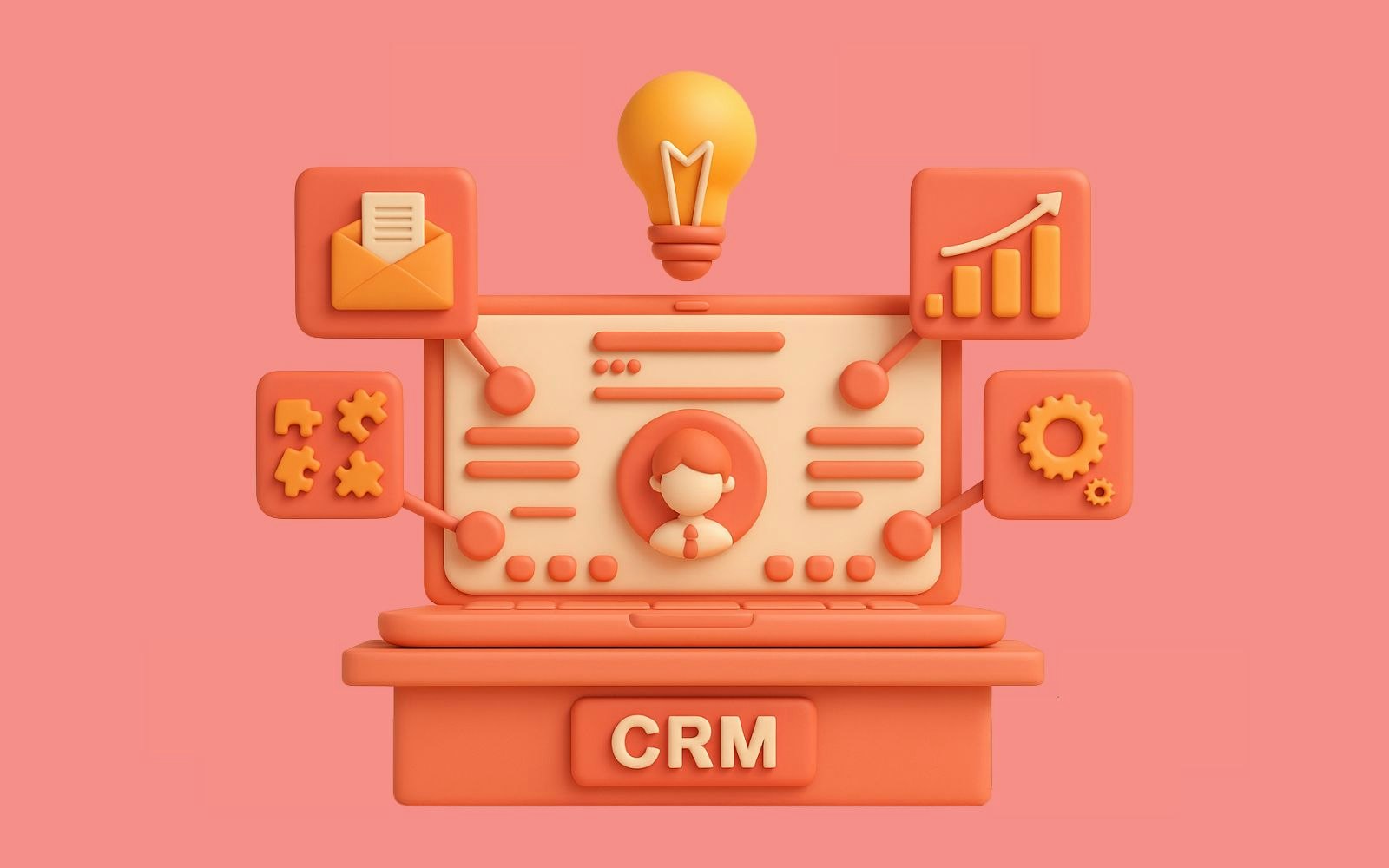
CRM Campaign: Creating high-performing marketing scenarios
8min • Last updated on Sep 1, 2025

Olivier Renard
Content & SEO Manager
The very first email was sent more than half a century ago, in 1971. Far from being outdated, it remains one of the most widely used channels by brands. By 2025, over 376 billion emails will be exchanged daily around the world: a figure that continues to grow, according to Statista.
In the early 1980s, the first CRM (Customer Relationship Management) software emerged. Their goal was simple: centralise contacts to better manage customer relationships. Since then, these tools have become a cornerstone of relationship marketing.
Today, CRM campaigns go far beyond sending emails. They orchestrate tailored scenarios and enable a lasting and personalised relationship with every customer.
Key takeaways:
A CRM campaign aims to strengthen the customer relationship through personalised messages across different channels.
It relies on precise segmentation and marketing automation, based on clearly defined scenarios and business objectives.
Email remains a key channel, but many other communication levers exist, such as SMS or push notifications.
A Customer Data Platform (CDP) boosts the performance of your CRM campaigns. It improves segmentation and facilitates customer data activation across your chosen destinations.
👉 What is the purpose of a CRM campaign, and how can you make the most of it? Discover how to create high-performing marketing campaigns by making data your greatest asset. 🚀
What is a CRM campaign?
A CRM campaign refers to a set of marketing actions carried out by a company to strengthen its relationship with customers and prospects.
It targets contacts already known to the company, stored in a CRM database. It may pursue several goals: retaining existing customers, preventing churn, re-engaging inactive users, or boosting sales.
It is an effective way to enhance the experience throughout the customer journey. Some of the most common techniques include sending a personalised welcome offer, birthday wishes, abandoned cart reminders, or loyalty rewards.
These campaigns rely on accurate and up-to-date customer data to deliver the right message at the right time. They use various channels: email, SMS, push notifications, or calls, depending on the customer's profile and the type of interaction desired.
💡 CRM, CRM strategy, CRM campaign: what’s the difference?
Term | Definition | Objective |
|---|---|---|
CRM (tool) | Software that organises customer data and optimises interactions. | Better manage customer relationships and personalise communication. |
CRM strategy | A comprehensive approach to enhancing the customer experience and relationship. | Create long-term value. |
CRM campaign | A set of targeted, often automated marketing actions triggered by customer data. | Strengthen customer relationships at key moments. |
CRM tool, CRM strategy and CRM campaign
Benefits for your marketing strategy
A well-designed CRM campaign is valuable in both B2B and B2C. It is part of a broader strategy and goes beyond simply sending emails.
It allows you to better support each customer based on their stage in the buying journey. To do this, you must deliver value and adapt to their needs, whether they are in the awareness (ToFu), consideration (MoFu), or decision (BoFu) phase.
Based on targeted communication, it's an effective lever to:
Optimise customer lifetime value (CLV),
Reduce acquisition and retention costs,
Maintain regular contact with your base to increase engagement and reduce churn,
Create personalised experiences that strengthen brand loyalty.
A CRM campaign fosters collaboration between teams: marketing, sales, product, customer success. By optimising interactions at every stage and touchpoint, it helps build a truly omnichannel experience.
Which channels should you use?
CRM campaigns are part of an outbound strategy. They can rely on a wide range of channels, each offering different advantages depending on the objective. Making the right choice is essential, especially as the cost of each varies considerably.
Email remains a cornerstone of customer relationship management. It enables personalised large-scale sends thanks to audience segmentation and automation. Cost-effective and offering a strong return on investment (ROI), email remains highly efficient when it comes to customer retention.
SMS is a more direct channel. It boasts high open rates (often over 95%) and is ideal for delivering short, urgent messages such as alerts or limited-time promotions.
Push notifications, whether through mobile apps or browsers, enable real-time interaction with your users. They align with an instant engagement logic and are especially well suited for mobile-first use cases.
Phone calls and voice messages still have their place in certain contexts: B2B appointments, high-value customer follow-ups, or post-sale service calls.
Social media also offers personalisation opportunities, particularly through retargeting campaigns based on first-party data. These channels serve as a valuable complement to traditional CRM tools.
🚨 Not all channels cost the same. Sending an email costs around £0.0003, compared to approximately £1 for a printed letter and £10 for a phone call. The final choice will depend on your budget, campaign objective, and the level of personalisation required.
💡 Focus on marketing automation
With intelligent workflows, it's possible to send automatically the right message at the right time.
These scenarios are triggered based on specific actions (clicks, purchases, inactivity...) or events such as a birthday or a change in customer status.
Campaigns become more responsive, better targeted, and reduce the need for manual intervention.
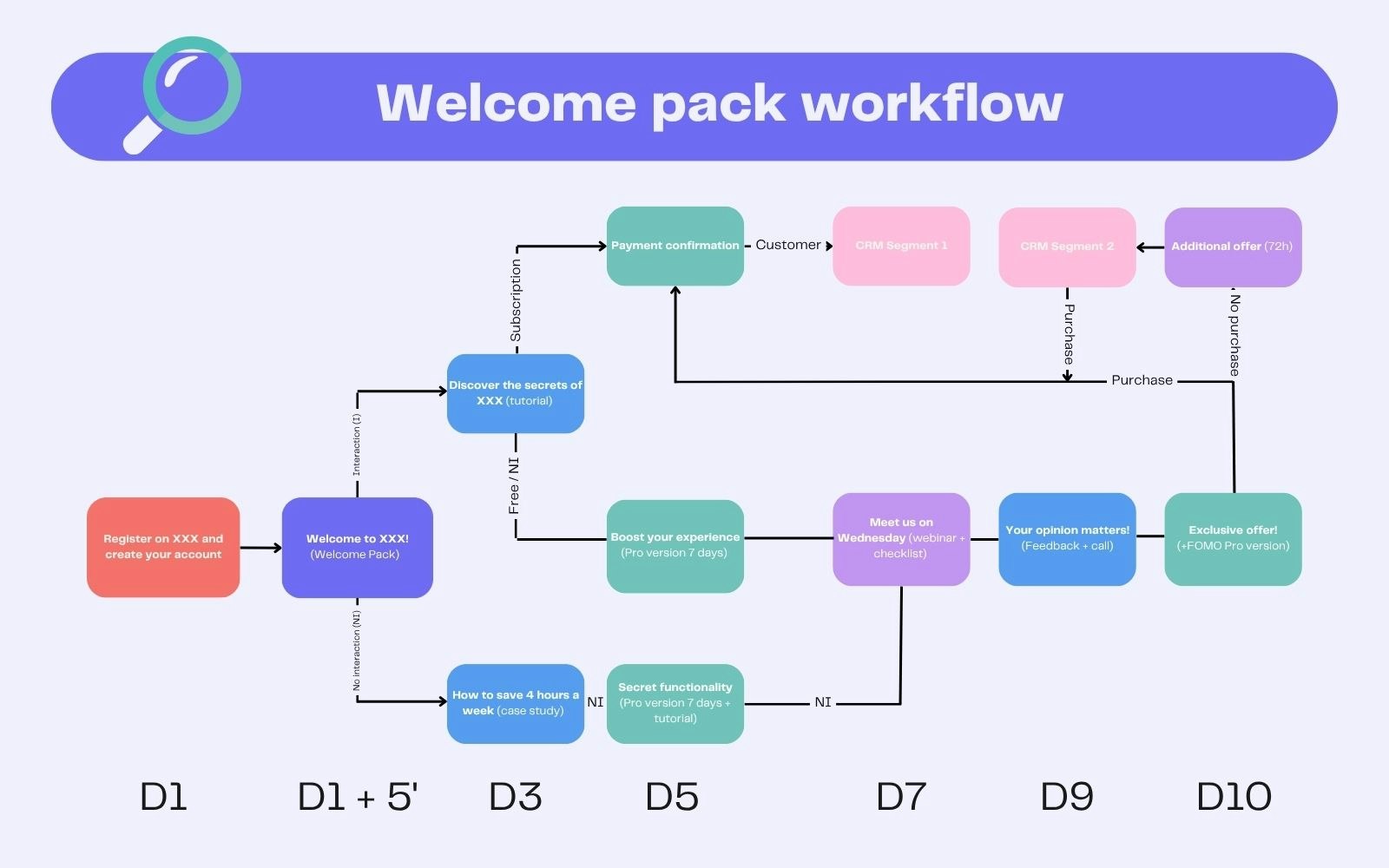
Example of a welcome pack email workflow
How to segment effectively?
Your objective is to deliver the right message, to the right person, at the right time. That means knowing exactly who you're speaking to. The success of your CRM campaign therefore relies on having a solid understanding of your customers.
At this stage, a common pitfall is adopting overly simplistic segmentation. It’s not enough to just distinguish between “new” and “existing” customers.
To offer relevant messaging, brands must rely on accurate and reliable data. This starts with the information they collect directly from their own channels: first-party data.
The main approaches
Behavioural: based on purchases, website visits, or engagement (clicks, email opens, etc.). Brands like Netflix, Airbnb, and Sephora are among the most advanced in this area.
Customer value-based: using indicators such as RFM scoring, lifetime value, or churn risk. This approach helps prioritise marketing efforts according to a customer’s profitability or potential.
Socio-demographic: segments built around age, gender, socio-professional category, or key life events (weddings, birthdays, births).
Geographic: based on region, city, or even real-time location. This is particularly useful for tailoring a campaign to a local context.
The aim remains the same: to tailor content, channel, and communication frequency to the expectations of each segment.
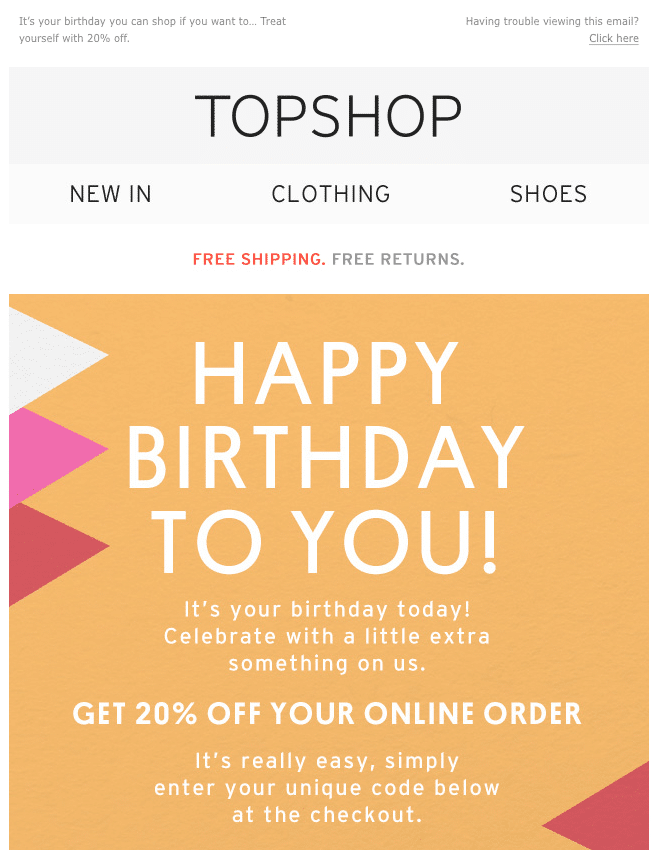
Topshop "Happy Birthday" Email
💡 The DinMo Customer Data Platform supports this approach by creating dynamic segments based on unified data. With the help of predictive AI, it goes even further by anticipating future customer behaviours.
The no-code features of our CDP give marketing teams greater autonomy and save valuable time for data teams.
Examples of successful campaigns and best practices
The most effective brands roll out creative CRM campaigns tailored to each stage of the customer journey. From welcoming new contacts with a welcome pack to nurturing loyal advocates, the possibilities are endless.
The omnichannel loyalty strategy developed by Sephora is a textbook example. The perfume and cosmetics retailer combines emails, SMS, and push notifications with personalised offers based on each customer profile.
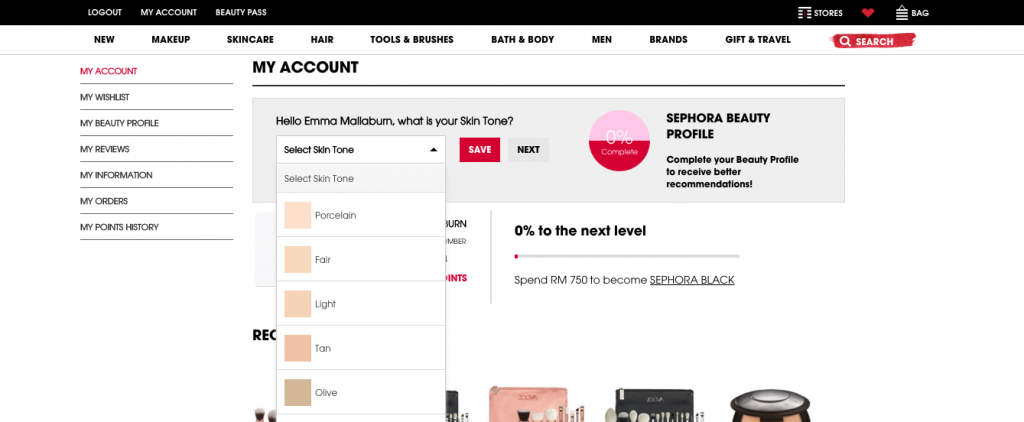
Sephora: Beauty Profile
Nespresso delivers a tailored experience through automation and precise segmentation. The capsule coffee brand follows up with its customers by email to anticipate refill needs and offers exclusive benefits depending on their Club status.
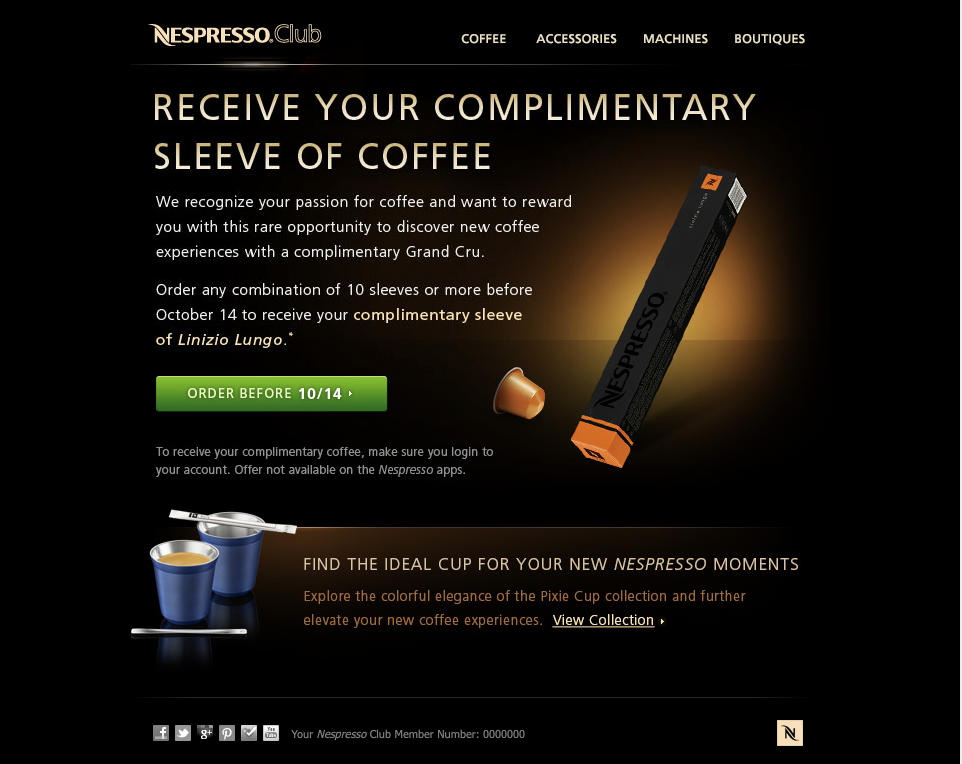
Nespresso club email
Airbnb, meanwhile, relies on targeted re-engagement campaigns based on previously searched destinations or past bookings.
Best practices
Always obtain explicit opt-in consent for each communication channel you use.
Favour authentic communication over cold or generic messaging.
Focus on engagement rather than frequency: a useful message is better than a string of irrelevant follow-ups.
In B2B, adopt a conversational tone and align marketing and sales to deliver a seamless customer experience.
Continuously improve your campaigns by measuring their impact with precision.
Measuring the effectiveness of your CRM campaigns
Some metrics are essential for managing your day-to-day activity, while others help assess the real contribution of your campaigns to business performance.
Key metrics to track
Open rate: For email campaigns, a good open rate typically ranges between 25% and 40%, depending on the industry. It is strongly influenced by the subject line and the initial hook of the message.
Click-through rate: This helps evaluate the relevance of your content. A low rate may indicate weak engagement or that your targeting needs adjustment.
Conversion rate: A key metric for determining whether the intended action (purchase, appointment booking, download, etc.) has been completed.
These core indicators can be supplemented with more advanced metrics:
Click-to-open rate: The proportion of recipients who clicked after opening the message.
Unsubscribe rate: A useful signal for detecting poor content or an overly aggressive sending frequency.
Other strategic business KPIs to go further
A high open rate is encouraging, but without clicks or conversions it holds little real value. To truly assess the impact of a CRM campaign, it’s better to track more strategic indicators:
Retention rate or, conversely, churn rate: how many customers remain active over time?
Revenue per customer or per campaign: how much revenue does each activation generate?
Customer Lifetime Value (CLV): do certain activated segments generate more long-term revenue than others?
More in-depth analyses can also be conducted on post-campaign behaviour: reactivated customer rate, repeat purchases at day 30 or 90, or changes in average basket size.
The most effective CRM campaigns follow a continuous improvement mindset. A/B testing, custom dashboards, and feedback loops with frontline teams should all be in place to learn and improve with each send.
📈 Vanity metrics vs. business indicators: to effectively manage your CRM campaigns, prioritise KPIs that reflect real impact on customer experience and overall business performance.
CDP and CRM: Two complementary tools
A CRM (Customer Relationship Management) stores contact information and facilitates the tracking of customer interactions.
Among the most widely used solutions on the market are Salesforce, HubSpot, Emarsys and Klaviyo. These tools are used by marketing and sales teams to manage day-to-day customer relationships.
However, a CRM alone is not sufficient to personalise customer journeys at scale. The reason? It does not centralise all the up-to-date data generated by a company’s operations. This is why we recommend using a data warehouse as a single source of truth.
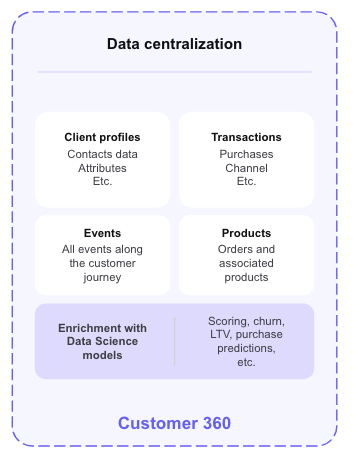
All the information we recommend centralising in a Single Source of truth
A Customer Data Platform (CDP), on the other hand, unifies data from all your sources: website, app, transactions, marketing campaigns.
A CDP enables you to:
Build complete and actionable customer profiles.
Create dynamic segments based on behaviour, value, or lifecycle stage.
Synchronise this data with all your marketing tools: CRM, advertising platforms, support tools.
Trigger automated, omnichannel campaigns tailored to each customer.
In other words, the CDP enhances your CRM campaigns by providing a 360° customer view and advanced activation capabilities.
💡 The benefits of DinMo’s composable CDP
Our composable CDP helps you fully leverage the data stored in your data warehouse, without duplication.
Build precise, actionable audiences using our 100% no-code visual segment builder.
Sync these segments with your CRM tools.
Activate your data on the right channel, with the right message, to launch targeted, effective campaigns.
🎯 Thanks to enhanced personalisation, our clients have seen click-through rates on CRM campaigns double and a significant drop in churn among at-risk segments.
The CDP does not replace the CRM, but rather complements it. It enables the deployment of a data-driven marketing strategy.
Conclusion
CRM campaigns are essential for maintaining long-term customer relationships. They boost loyalty and improve marketing performance.
By adopting a data-driven approach, you can personalise your messaging at scale and engage your customers at the right time, through the right channel.
CRM structures interactions. The CDP unifies data and allows you to activate audiences in real-time.
With DinMo’s CDP, automate your CRM campaigns and turn your marketing into a genuine growth driver. Contact us to learn more!


















